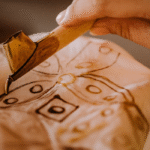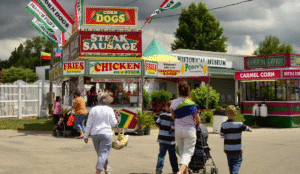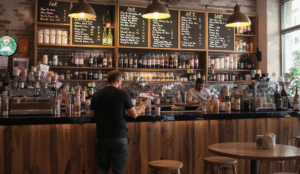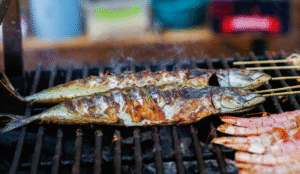Why Is Nasi Kerabu Blue? Malaysia’s Famous Blue Rice
When you travel through Malaysia’s East Coast, you’ll stumble upon a dish so striking it turns heads at any food market — nasi kerabu. This vibrant meal isn’t just a feast for your eyes, it’s deeply rooted in tradition, community, and nature’s hidden colors. But What makes Nasi Kerabu blue? Why do we Malaysians still celebrate it so proudly today? Let’s dive into the story behind Malaysia’s most iconic blue rice.
Frequently Asked Questions (FAQ)
1. What makes Nasi Kerabu blue?
The iconic blue rice gets its vibrant hue from the butterfly pea flower (bunga telang). Soaking the petals in hot water extracts a natural blue pigment used to cook the rice.
2. Is blue pea rice healthy?
Yes! Butterfly pea flowers are packed with antioxidants like anthocyanins that may help reduce inflammation and boost overall wellness.
3. What is the difference between nasi ulam and Nasi Kerabu?
Nasi Ulam mixes shredded herbs directly into the rice, while Nasi Kerabu serves fresh herbs and vegetables on the side of its signature blue rice.
4. Is there natural blue rice?
Rice doesn’t grow blue — but the butterfly pea flower naturally dyes rice blue when steeped in water, so the color is 100% natural.
5. What does butterfly pea do to your body?
Butterfly pea is believed to support healthy skin, hair, and brain function thanks to its antioxidants. Many people drink butterfly pea tea for its soothing effects.
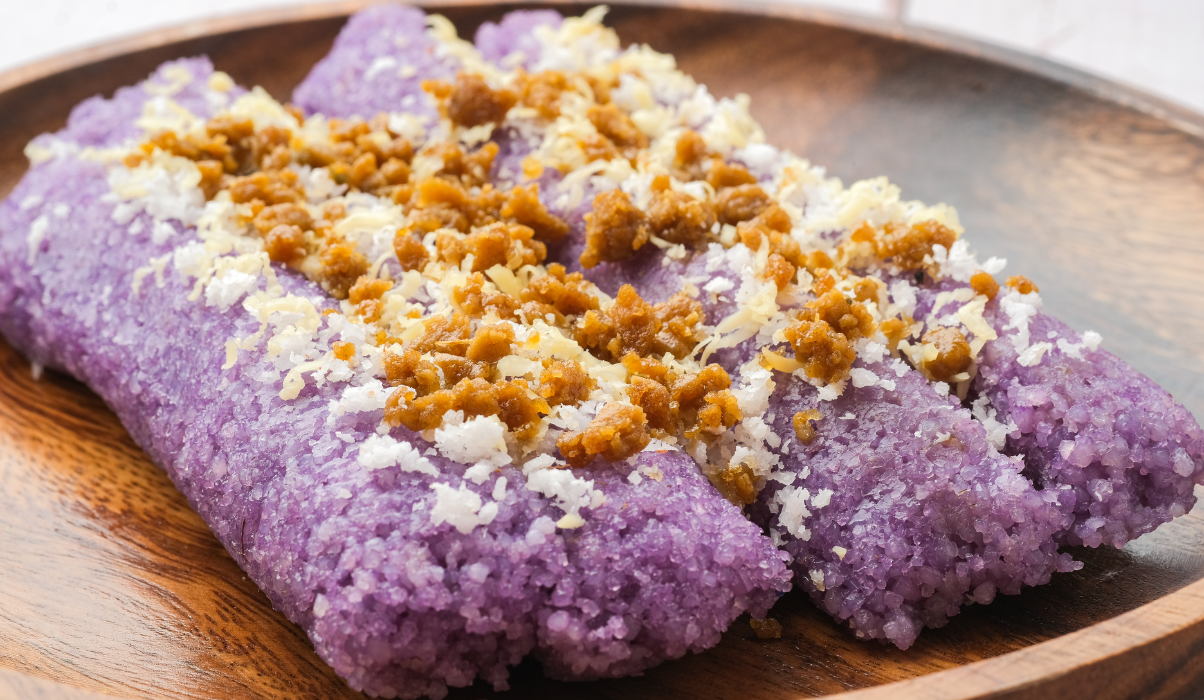
A Glimpse Into The Origins of Nasi Kerabu
Nasi Kerabu is a beloved Kelantanese dish, famously served with nasi kerabu as its centerpiece. Historically, the East Coast states of Kelantan and Terengganu have rich Malay traditions where local herbs (ulam), fermented fish sauce (budu), and fresh vegetables are daily staples.
Back then, people didn’t have fancy artificial colorings — they used what nature offered. That’s where the butterfly pea flower (bunga telang) comes in. This humble flower grows wild along fences and gardens across Malaysia. Our grandmothers knew What makes Nasi Kerabu blue? — they’d pluck the petals, steep them in warm water, and let the natural dye transform plain white rice into stunning blue rice.
The Magic Behind The Blue: What Makes Nasi Kerabu Blue?
So, What makes Nasi Kerabu blue? The secret is all in the butterfly pea flower. When soaked, these vivid blue petals release a natural pigment called anthocyanin — the same antioxidant compound found in blueberries. This pigment binds to the rice grains while steaming, turning ordinary rice into an enchanting blue delight.
In Kelantanese homes, the deeper the blue, the prouder the cook! Some families even mix in other natural colorings, like turmeric or pandan, to create a multi-colored rice platter. But the star is always the blue rice — a symbol of tradition, creativity, and connection to the land.
Cooking Blue Rice: A Family Affair
Ask any Kelantanese auntie — cooking Nasi Kerabu is not just about food, it’s an event. The butterfly pea flowers are freshly picked in the morning and gently washed to remove any dust. A handful of petals are soaked in hot water for 10–15 minutes until the water turns a deep sapphire blue. This blue liquid is then mixed with washed rice and steamed the traditional way.
Mothers and daughters often gather in the kitchen, preparing the side dishes that make blue rice so special — grilled fish or fried chicken, salted egg, fish floss (serunding ikan), coconut sambal, and fresh herbs like torch ginger and lemongrass.
The result is a beautiful plate of nasi kerabu, raw vegetables, crispy crackers, and punchy sauces that delight all your senses.
Is Blue Pea Rice Healthy?
Many curious food lovers ask, Is blue pea rice healthy? Good news — yes, it is! The butterfly pea flower is naturally rich in antioxidants, especially anthocyanins, which may help protect your cells against free radicals.
Unlike artificial food coloring, this natural dye adds zero calories but brings subtle plant-based nutrients. Traditional medicine even uses butterfly pea flowers for their calming effects — some claim it helps with stress, memory, and healthy skin. So next time you eat blue rice, you’re not just enjoying a pretty meal — you’re nourishing your body, too.
The Cultural Significance of Blue Rice in Malaysia
Nasi kerabu isn’t just food; it’s an edible link to our Malaysian identity. In the kampungs of Kelantan, sharing Nasi Kerabu brings families, friends, and neighbors together. It’s often enjoyed during special gatherings, festive occasions, or even just as a hearty breakfast at the local warung.
Elders say the butterfly pea flower reminds us of how Malaysians have always used plants wisely — from cooking to healing. This makes blue rice a symbol of sustainability, respect for nature, and pride in our culinary heritage.
The Modern Revival: Blue Rice Around the World
In the Instagram age, nasi kerabu has taken on a new life. Across Asia and beyond, the butterfly pea flower is now used by chefs, baristas, and home cooks to add natural blue color to all sorts of food and drinks.
In Thailand, people make blue sticky rice (khao gam) with coconut milk and mango. Cafes whip up butterfly pea lattes, blue mooncakes, and colorful dumplings. Some high-end restaurants serve blue rice sushi rolls or use the flower to tint cocktails and mocktails.
This global trend shows how a humble kampung flower can inspire modern creativity while reminding us of Malaysia’s culinary roots. And yes — it’s still natural! So if you’re ever asked, Is there natural blue rice? you can proudly say: “The rice itself isn’t grown blue — but the color is all-natural, thanks to butterfly pea.”
A Deeper Look: Modern Twists of Blue Rice Around the World
In today’s age of food trends, the butterfly pea flower’s beautiful pigment has found a new purpose far beyond Malaysia’s East Coast. The same natural color that makes our traditional blue rice so iconic has inspired chefs and food innovators globally.
In Bangkok, trendy cafés serve butterfly pea lattes layered with coconut milk — the deep blue blending into pure white creates an ombre drink that’s as photogenic as it is refreshing. Some places drop a bit of lime juice in — watch the magic! The blue turns purple thanks to the flower’s natural pH sensitivity. This playful transformation is why mixologists love using butterfly pea to craft cocktails that shift colors right before your eyes.
In Japan, adventurous chefs have started using butterfly pea to tint sushi rice. Imagine your favorite sushi roll wrapped in seaweed with striking blue grains — a subtle nod to Southeast Asia’s influence. Meanwhile, in Bali, resorts serve blue pancakes and butterfly pea gelato, giving tourists a taste of Malaysia’s color magic.
In the US and Europe, the flower is becoming a superfood trend. Health shops sell dried petals as herbal tea or smoothie boosters. Many health-conscious foodies ask Is blue pea rice healthy? and love that the answer is a big “yes” — you get stunning color without artificial additives.
Is There Natural Blue Rices? Myth vs. Reality
So, Is there natural blue on the rice? Genuinely blue rice grains do not exist in nature. Rice plants produce grains that are white, brown, black (like black glutinous rice), or red — but never blue.
The vivid blue hue of nasi kerabu comes from the infusion of butterfly pea flowers. The flower’s anthocyanins bind to the rice during cooking, creating that signature look. It’s a clever trick our ancestors figured out long before food coloring bottles hit supermarket shelves.
This use of plants for coloring is a testament to traditional Malay resourcefulness. It’s proof that sometimes, the simplest ingredients make the biggest impact.
Farm to Table: How Malaysians Grow and Use Butterfly Pea
While global chefs treat butterfly pea as an exotic superfood, here in Malaysia, it’s often just growing by the fence! Many kampung houses still have butterfly pea vines twirling up their gates. They thrive in our humid climate and require little care — just sunshine, rain, and a supportive trellis.
In the old days, kids would pluck the vivid petals to play or help mothers prepare the daily blue rice dye. Some elders remember rinsing the flowers in tin basins while gossiping with neighbors — proof that What makes Nasi Kerabu blue? is not just the flower but the social ritual around it.
Besides nasi kerabu, Malaysians use butterfly pea in nyonya kuih, herbal drinks, and even traditional remedies. Many believe it helps soothe coughs or boosts eyesight. It’s a plant that shows how resourceful Malaysian cooking truly is.
More Than Just Pretty: Is Blue Pea Rice Healthy? The Science Behind It
Let’s dig deeper: Is blue pea rice healthy? The short answer is yes, but here’s why.
The butterfly pea flower contains anthocyanins — antioxidants also found in blueberries, black rice, and purple cabbage. These compounds may help fight free radicals, which are unstable molecules that damage cells. Free radical damage is linked to premature aging and certain diseases, so adding a natural source of antioxidants — like butterfly pea — is a gentle boost for your daily diet.
Some herbalists claim the flower can help with hair growth, eye health, and mental clarity. That’s why you’ll sometimes see beauty brands adding butterfly pea extract to shampoos or skin products.
So when you eat blue rice, you’re not just enjoying eye candy — you’re giving your body a little extra plant power.
Nasi Ulam vs. Nasi Kerabu: Know The Deeper Differences
People often mix up these two herbal rice dishes. On the surface, both champion fresh herbs, local vegetables, and rice as the base. But when you look closer, the differences tell two stories about Malaysia’s culinary diversity.
Nasi Ulam is common in the West Coast states like Penang, Perak, and Selangor. The name ulam itself means raw herbs. You’ll find shredded turmeric leaves, Vietnamese coriander, torch ginger, and wild pepper leaves finely chopped and mixed through freshly steamed rice. Every mouthful bursts with fragrance. There’s no blue rice here — the rice stays white or slightly green from the herbs.
Nasi Kerabu, on the other hand, is an East Coast pride — especially Kelantan’s. Instead of mixing herbs in, the herbs come as a fresh raw salad on the side. The hero is the blue rice — dyed lovingly with butterfly pea. Another must-have? Budu, the pungent fermented anchovy sauce that adds umami depth. Nasi Kerabu’s sides vary but often include salted egg, fried fish, coconut sambal, crispy fish crackers (keropok), and grated coconut with spices (serunding).
So What is the difference between nasi ulam and Nasi Kerabu? Simply put: mixed herbs vs. side herbs, white vs. nasi kerabu, West Coast vs. East Coast. Both are equally delicious and reflect how Malaysians adapt nature’s gifts in different ways.
The Color Myth: Is There Natural Blue Rice?
We know the answer is technically no — Is there natural blue rice? Not in the fields. Rice grains grow white, brown, red, or black. So how did the “blue rice” label stick?
In older times, people marveled at this beautiful color on the dinner table. Back then, food was plain and seasonal — having blue rice felt like a treat. Some folklore even claimed butterfly pea had magical properties, protecting the home and the body.
Today, we know the science: the anthocyanin pigment does all the work. It’s the same family of compounds that gives blueberries and purple cabbage their deep hue. This means blue rice isn’t genetically blue — it’s naturally dyed during cooking.
Some modern seed breeders have experimented with rice strains to create grains tinted purple or deep red — but never truly blue. So next time someone wonders Is there natural blue rice? you can smile and say, “No, but we Malaysians have the next best thing!”
Butterfly Pea Flower: What Does It Really Do To Your Body?
Curious foodies always ask: What does butterfly pea do to your body? While it’s no magic cure, studies show this flower is rich in anthocyanins, which can help reduce inflammation and oxidative stress.
Some Southeast Asian traditional medicine systems use butterfly pea to cool the body and calm the mind. In Ayurveda, it’s known as shankhpushpi and believed to aid memory and focus.
In Thailand, it’s common to serve butterfly pea tea as a digestive after meals. In Malaysia, you’ll find it brewed hot or iced with honey and lime. It’s caffeine-free, gentle on the stomach, and perfect as a bedtime drink.
A fun twist? Add a squeeze of lemon — watch the drink turn from deep blue to purple. This wow factor alone keeps the butterfly pea trend alive in modern cafés.
How to Make Blue Rice at Home
Want to try this at home? It’s easy! Here’s a simple way to recreate Nasi Kerabu’s iconic blue rice:
Ingredients:
- 2 cups white rice (jasmine or long-grain)
- 20 fresh or dried butterfly pea flowers
- 2 cups water
- A pinch of salt
Steps:
- Rinse the butterfly pea flowers gently. Soak them in 2 cups of hot water for 10–15 minutes until the water turns deep blue.
- Rinse your rice as usual.
- Strain the blue water and pour it into your rice cooker or pot. Add more water if needed, according to your rice package instructions.
- Add a pinch of salt.
- Cook the rice as you normally would.
- Fluff and serve!
Pair your homemade blue rice with fresh herbs, sambal, salted egg, or grilled fish — and you’ve got your own version of Nasi Kerabu.
Blue Rice in Modern Malaysian Food Culture
Today, nasi kerabu is more than just a traditional village dish. It’s on café menus in Kuala Lumpur, featured in food festivals, and even used in fusion recipes that surprise tourists and locals alike.
Young chefs love experimenting with butterfly pea flowers, blending tradition with modern plating. You might find blue rice poke bowls, butterfly pea infused sushi, or even rainbow-colored rice where blue joins yellow turmeric rice and pink beetroot rice on the same plate.
These modern twists keep the heritage alive — while showing the world that Malaysian food can be fresh, fun, and Insta-worthy.
A Final Word: Why We Love Blue Rice
From kampung gardens to Instagram feeds, blue rice tells a story of old wisdom and modern playfulness. It’s proof that our grandmothers were natural chemists, transforming humble ingredients into visual art long before “food aesthetic” was a trend.
What makes Nasi Kerabu blue? It’s not just the flower — it’s our collective pride in Malaysia’s culinary heritage.
Is blue pea rice healthy? Absolutely — and it’s gentle on your body and the environment.
What does butterfly pea do to your body? It soothes, nourishes, and reminds you that nature’s colors are always better than artificial ones.
Whether you’re trying blue rice for the first time or grew up eating it every Raya, remember: every blue grain connects you to centuries of stories, flavors, and family gatherings.
So here’s to the humble butterfly pea flower — may it keep our rice blue and our memories vivid for generations to come.
